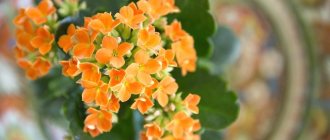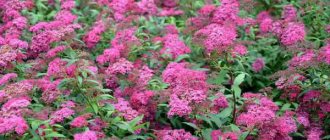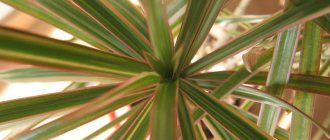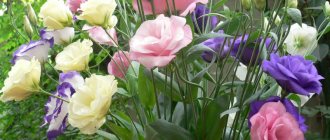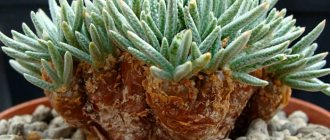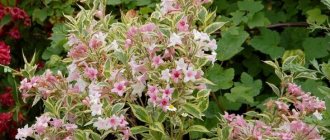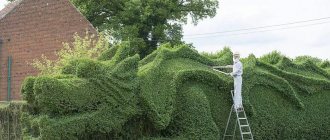Evergreens are not the only group of plants that do not lose their decorative properties even in winter. You'd be surprised how many crops stay green until spring!
From the point of view of the average person, evergreen and wintergreen crops are one and the same, because both retain the rich color of their foliage in winter. And yet these plants have certain differences.
Evergreens are plants whose leaves live for 2-3 seasons, and wintergreens are those crops whose foliage does not fall in the fall, but remains until spring. Nature has increased the duration of photosynthesis, giving wintergreens the ability to retain last year's foliage until this year's leaves appear on the plant. Let's take a closer look at some of them!
Badan
The skyward peduncles of bergenia decorate the flowerbed, and its large leathery leaves refresh the flower garden in early spring. In addition, this plant is very hardy and does well in shaded areas with loamy soil.
In the spring, after the snow has melted and the soil has dried out a little, the most damaged leaves are removed from the bergenias. Please note that all shoots and leaf blades cannot be removed, no matter how untidy they may seem to you, because... Nature endowed bergenia with non-freezing leaves for a reason. They are necessary for the plant to maintain the required temperature of the shallow rhizomes of the plant.
At the end of April - beginning of May, the plant begins to bloom and continues to do so until the end of June. In autumn, depending on the variety of bergenia, its leaves may acquire a bronzed or bluish-brown tint, which remains until spring.
Common heather
The evergreen shrub called "Calluna Vulgaris" or common heather is the only species of the genus Ericaceae. It has highly branched stems 25-50 cm high with reddish-brown bark, framed by small triangular leaves of a pale lilac hue. The small flowers of the plant, collected in umbellate or racemose inflorescences, depending on the variety, can have a white, lilac or pink tint.
The most common types:
- Treelike - evergreen, low-growing trees with needle-like foliage and flowers that resemble miniature bells.
- Ornamental - dwarf shrubs with short, needle-like foliage and tiny flowers of white or purple color.
- Pink - plants with thin stems, framed by narrowed oval leaves of a rich greenish-red hue. From April to May it is decorated with flowers in red and white shades.
Almost all species are suitable for cold climates. They feel comfortable on sandy loam and depleted sandy soil types. In landscape design, low-growing evergreen shrubs are most widespread as decorations for rockeries and rock gardens, as well as for arranging flower beds and decorating edges surrounded by garden trees. Thanks to the varietal diversity of heathers, you can endlessly combine the height of the “cushions”, the color of the flowers and the timing of flowering.
Euonymus Fortune
A relatively low, 50-60 cm plant, which can grow in “volume” up to 2-3 m, so it can be grown on a trellis. Among Fortune's euonymus varieties there are both monochromes and bicolors, which makes this culture especially popular among landscape designers.
Euonymus grows slowly, so it does not require frequent pruning. In early spring, all damaged and frozen leaves are removed from the euonymus. Most varieties of this type of shrub can boast of their frost resistance, but in the first years it is recommended to cover it during the winter. Adult plants are not covered, but their trunk circles are mulched with sawdust or peat.
- Euonymus Fortune
The most elegant and very frost-resistant euonymus, which decorates the garden all year round thanks to its variegated leaves.
Red stamen callistemon
A representative of the myrtle family, whose name is translated from Greek as “kallos - beautiful and stemon - stamen”, is widely popular among landscape designers due to the unusual shape of the flowers. Its cylindrical inflorescences, strewn with thousands of stamens, look like plumbing brushes. In places where they bloom, spherical fruits with a hard skin are formed.
The shrub plant has another amazing ability: to unfold its leathery, hard leaves with the edge facing the sun's rays. In this way, it protects itself from heat and moisture loss.
There are over 25 species in nature. The following varieties are most widely used as cultivated plants:
- Callistemon lanceolatus - has narrow lanceolate leaves of a gray-green hue. Inflorescences collected from long red-burgundy stamens can reach sizes of up to 10 cm.
- Callistemon citrinus - a shrub up to 4 meters high has straight bare branches framed by lanceolate, slightly pointed leaves with clearly visible veins. It blooms profusely from June to July, wearing spike-shaped inflorescences 5-10 cm long.
- Callistemon viminalis - the main feature of the shrub is that its shoots are heavily covered with silky long hairs.
Evergreen trees and shrubs can reach a height of 50 cm to 1.5 m, making them excellent both as terraces and open areas.
Monetary loosestrife
A moisture-loving ground cover that fits perfectly into the composition with any body of water. Although loosestrife prefers moist soils, it really does not like stagnant water, so when you decide to plant it on your site, you will need to provide it with good drainage. For wintering, the loosestrife is not covered, but sanitary pruning is carried out, and the soil around the bush is loosened and mulched with humus or compost.
Powerful creeping stems tightly cover the ground, not giving weeds the slightest chance. This plant is very unpretentious, but maximum decorativeness can be achieved only by planting it in a sunny area and providing it with sufficient watering, since the loosestrife loves moisture very much.
- Unquestioned groundcovers - the best plants for garden paths
6 Ground Cover Plants You Can Walk On.
ENVIRONMENTAL BLOG
Evergreens maintain their green color throughout the year, regardless of the season. This is a rather specific type of plant, which has a number of undeniable advantages over deciduous plants. Evergreen trees and shrubs can delight with their rich color all year round, which is very important for landscaping around the house, in parks and public gardens. We will talk about the features of evergreen plants in this article.
Where do evergreens grow?
On our beautiful planet, needle-shaped evergreen forests grow - these are mainly forests of the Northern Hemisphere. Evergreen trees such as spruce, pine, fir, podocarp and others are widespread here . In addition to needle-shaped evergreens, there are also deciduous evergreen trees, vines and shrubs that inhabit the temperate rain forests of the Southern Hemisphere. The xerophilic (thick, hardened foliage that resists water loss) coastal forests of the Northern Hemisphere are home to evergreen rhododendrons (Pontic, dense rhododendron), cherry laurel and holly.
Most tropical rain forests contain broadleaf evergreens. Their foliage is usually thicker and more leathery than that of common deciduous trees. Additionally, each leaf can remain on an evergreen tree for two or more years. An example of this is the evergreen cocoa tree. Cold-temperate and arctic regions typically grow cone-shaped shrubs or coniferous trees such as pine and spruce.
Evergreens in gardening art
The unusual forest color of spruces and pines serves as an effective basis for any park or garden, and decorative bushes are a kind of addition. Such a union of tiers will ensure the attractiveness of the site throughout the entire life of evergreens.
There are various options for combining needle-shaped and deciduous evergreens for planting near the house. For example, spruce, honeysuckle, cypress, juniper, fir, ivy, boxwood, bristlecone pine, yew, thuja and some types of rhododendron can perfectly zone the landscape, especially in combination with decorative seasonal plants.
When planning planting on your site, it would be right to focus on evergreens. It is they who must form the basis on which all other inhabitants of the garden will rely. After the completion of seasonal flowering, such a garden will not be boring even in the winter season. If your garden seems empty and bare, this is a sure sign that you should add winter green plants to your garden.
Evergreen trees and bushes can be placed separately from each other or in groups, combining their different types. Evergreens are suitable for hedges, which is not only practical, but also environmentally friendly.
With the help of evergreens it is possible to satisfy any aesthetic needs in design. Miniature shrubs, which can be given almost any shape, fit perfectly into small gardens. If the area of the territory allows, then you should definitely plant majestic tall trees. Moreover, in both cases, the height and size can be adjusted by trimming. Evergreens are a good material for gardening creativity. Shrub sculptures, or topiary as they are also called, can increasingly be seen not only in city parks, but also near residential buildings.
The undeniable advantage of flowering varieties of evergreens is that they do not require much additional care and will not complicate the gardening schedule, as happens when other crops bloom. Thus, with minimal effort, you can ensure a well-groomed look in almost any garden.
The most popular evergreens
Below are examples of the most famous evergreens:
- Spruce trees will be a good solution for garden decoration. Of course, not every variety of this majestic tree will suit every garden. European or common spruce is the most common evergreen tree when decorating summer cottages, squares, and alleys. Many varieties of this tree have been developed, differing in needle shade, size and growth rate. On average, the height of spruce is from 30 to 50 meters, and the width is up to 5 meters. This cone-shaped tree can live up to 300 years without any care. Of course, more decorative varieties of spruce are suitable for domestic cultivation: “Akrokona”, “Inversa”, “Maxveli”, “Tompa”. In addition, in addition to its aesthetic value, common spruce will become a good barrier from winds and snow for other plants, and will also serve as raw material for useful medicinal tinctures.
- A slightly less common coniferous plant is Araucaria chilean . The cone-shaped crown of this tree with triangular needles looks very original. The younger the tree, the more picky it is to growing conditions and needs additional care, and the older it gets, the more severe conditions it can withstand.
- Thuja . A dense crown of unusual needle-like leaves and a pleasant aroma make the evergreen thuja shrub a leader in landscape design. To date, more than 100 species of thuja have been bred, among which tall and miniature shrubs with a variety of colors - green, golden, blue and reddish shades enrich the garden with their wide range. These evergreens are excellent for pruning and haircuts, but to keep their shape, it is better to tie the thujas with thick rope for the winter.
- Japanese umbrella fir is a pyramidal coniferous tree that is quite picky about environmental conditions. For good fir growth, only moist, oxidized soil is suitable. Needles up to 15 centimeters long resemble umbrellas, which explains its second name “umbrella pine.”
- Recently, small evergreen boxwood , which are used to decorate borders and fences, are gaining popularity in personal plots. The ability to grow in shaded areas and be trimmed in a variety of shapes and levels of difficulty make this plant suitable anywhere in the garden. It is worth remembering that boxwood leaves are poisonous and unsuitable for consumption. Therefore, after working with a plant, you must wash your hands!
- Rhododendron is one of the most famous flowering shrubs, but it is not the only one.
- Several Mahonia bloom yellow flowers in spring.
- Photinia Fraser will decorate the garden with small white fruits during the flowering season .
- Wintergreen acuminate - a spectacular fruit plant with red berries is ideal for combining with other types of plants, as it easily gets along with its “competitors”.
"Compact" evergreens
It is not at all necessary to focus on large winter-green trees and bushes. Today it is impossible to imagine small front gardens, alpine hills and narrow flower beds without dwarf varieties of evergreen plants. Just like in large areas, they are used to create mini-accents in areas of limited area. Thanks to its small size, it will be easy for anyone, even a completely inexperienced gardener, to maintain the neat shape of plants in perfect condition.
The compact leader of landscape zones is blue spruce , the height of which does not exceed 3 meters, even in old age. With its thick cone-shaped shape, it will fit into any flower bed. In second place in popularity is the slow-growing cypress . Japanese black pine , despite its impressive name, is completely harmless in appearance due to its compact crown and small 2.5-3 meter height. The oriental thuja by a meter height and a bright yellow color.
There are many flowering miniature evergreen shrubs that will enhance the area with their discreet and “intelligent” appearance. Among them is cherry laurel , whose crown diameter is more than twice its height. During the flowering season, the inflorescences of creeping rhododendron and Forrest rhododendron completely envelop the entire bush.
Juniper “Blue Carpet” is a very good option for decorating cascades over walls. This fast-growing plant with silver-blue evergreen foliage reaches 15 cm in height and 15-50 cm in width. Japanese garden juniper is a dwarf evergreen plant that reaches a height of 60 cm and forms a dense mat 30 to 40 cm wide.
This concludes our brief review of evergreens. And although we have not mentioned all the representatives of the flora that fall into this category of plants, most evergreen trees, bushes and vines have the same ability to delight our eyes and souls with their bright greenery even in the middle of winter.
Source: Environmental blog (ruslo.info)
- 8
Shares
Heather
Heathers are universal plants that will be equally appropriate in a variety of compositions. Tall (40-60 cm) varieties are a good background for multi-level compositions. Medium-sized (30-40 cm) are often used to create compositions in rockeries and rock gardens. Dwarf heathers, plants up to 30 cm high, are planted in groups that form real thickets. The main thing you need to know about heather is that it loves the sun very much.
In the southern regions and central zone, heather overwinters without additional protection from the cold. But if your area is characterized by cold and snowless winters, then it would be better to play it safe: mulch and cover with spruce branches.
- Everything you wanted to know about heather - planting, care, propagation, popular varieties
Detailed instructions for growing and propagating heather for those who decide to transform their garden with the help of this stylish and spectacular plant.
List of the best evergreens for the garden
All crops that preserve greenery all year round can be divided into two groups. Let's talk about each of them.
Conifers
Their main difference from other plants is their leaves in the form of thin, long needles. Some conifers have flat, scaly foliage. Almost all seeds ripen in cones, the shape, size and shade of which depend on the species. We list the most popular evergreen conifers among gardeners.
Spruce
A beautiful fluffy tree with short needles and brown cones. The average height of a tree is 25-30 m, under favorable conditions it grows up to 50 m. Spruce trees tolerate shading well and can grow in partial shade and in the sun. Sensitive to humidity and air purity. They prefer slightly alkaline light soils and moderately moist loams. There are more than 45 varieties of conifers. The following types can be recommended for the site.
- Ohlendorffy. A multi-topped, low-growing Christmas tree with needles of a golden-green hue. Grows up to 200 cm.
- Akrokona. Compact spruce up to 400 cm high, grows very slowly. The needles are dark green, the cones are lilac-crimson.
- Herman Nau. Dwarf Christmas tree no more than 150 cm high. The crown is cushion-shaped, the needles are grayish-blue.
Spruces are good in single and group plantings, for example, at the front entrance to a house or as the central figure of a multi-tiered composition. Dwarf and low-growing specimens are planted in mixborders or rockeries, and they are used as hedges.
Pixabay
Instagram green_garden.ua
Cypress
Tall conifer with scaly leaves. The crown can be pyramidal or spreading. Does not like bright sun rays and strong shadow. The best option is partial shade. Prefers loose fertile soil mixtures. It does not tolerate waterlogging; in lowlands it is planted only on well-drained soils. We list the best varieties for decorating the local area.
- Large-fruited. A tall tree with beautiful yellowish needles. Can grow up to 35-40 m, so pruning is required. Has a very pleasant lemon aroma.
- Tuevidny. A compact tree with a pyramidal crown of bluish-green color. Its peculiarity is the presence of needle-like needles, which gradually turn into scaly ones.
- Leyland. Tall, fast-growing hybrid with a columnar crown and scaly needles. The trunk is covered with glossy bark of a dark red or brown tone.
Cypress trees are unpretentious and tolerate pruning well. Low-growing varieties can be used as a basis for topiary.
Pixabay
ShutterStock
- Landscape
How to harmoniously integrate conifers into the landscape design of a garden: tips and 60 photos
Yew
Beautiful slow growing conifer. There are shrub and tree varieties. The needles are short, soft, very pleasant to the touch, and have a rich green hue. Produces fruits in the form of scarlet berries. Yew is shade-tolerant and unpretentious. It takes root well on any soil, but prefers a fertile neutral substrate without excessive moisture. We list the best varieties for landscaping.
- Pointed. Tree species can reach 20 m, but on average do not grow higher than 6 m. Shrub species are low and creeping. The needles are crescent-shaped, dark green on top and light on the back.
- Short-leaved. Multi-stemmed, slow-growing tree, growing from 5 to 15 meters. The crown is wide, shaped like a pin. The needles are flat and straight. The berries are bright scarlet.
- Canadian. Frost-resistant shrub-type variety. Grows up to 100-150 cm in height and up to 300-400 cm in width. In winter, the needles take on a red-brown hue.
All cypress trees tolerate pruning well, which is used in landscape design to create topiaries and park sculptures. You need to know that cypress cones, bark and needles contain substances that are toxic to humans and animals. Therefore, you need to be careful when planting it where children and pets will walk.
Pixabay
ShutterStock
ShutterStock
Thuja
Decorative conifer with many varieties. Among them there are dwarf shrubs that grow up to half a meter, and seventy-meter giant trees. Thujas are unpretentious, frost-resistant, grow well in partial shade and shade. Young seedlings have soft needles, which over time turn into scaly needles. These varieties can be recommended for the local area.
- Brabant. Belongs to Western varieties. Frost-resistant, fast-growing thuja with emerald needles. The crown is pyramidal in shape. Under natural conditions it can grow up to 40 m; in decorative plantings it does not exceed 4 m.
- Biota. An oriental variety with small needles pressed tightly to the branches. The crown is openwork-pyramidal. The cones are small, greenish-blue, dark brown when ripe.
- Japanese. Decorative coniferous tree up to 9 m high. The crown is pyramidal, the branches are directed upward. The needles are emerald green with a silvery tint and have a strong, pleasant aroma.
Thujas are very different, which makes it possible to choose the most suitable type for your site. They go well with other plants, especially boxwood, juniper, and barberry. Suitable for arranging hedges, flower beds and single plantings.
Pixabay
Pixabay
- Landscape
Planting thuja in open ground: useful tips and step-by-step instructions
Deciduous
Deciduous plants differ from conifers in the presence of lamellar petiolate foliage. Its shape and size can be very different. We offer names and photos of deciduous evergreens for the garden.
Heather
A monotypic creeping shrub with a height of 25 to 70 cm. It has many upward-pointing branches covered with small triangular leaves. They are bright green, slightly rolled into a tube. In midsummer the heather blooms. It is covered with bells of a lilac-pink hue. The plant is unpretentious, prefers open areas and slightly acidic soils. Feels normal on poor soils. For landscape decoration, we can recommend these varieties of heather.
- Erika. It grows as a subshrub, shrub or tree with small, pine-like leaves. The pink or white flowers resemble drooping bells and are collected in large clusters.
- Yana. Compact shrub up to 30 cm high. The branches are very dense, straight, directed upwards. The flowers are large, double, bright pink. Flowering begins in early autumn and ends in November.
- Carmen. A compact, round-shaped bush 30-40 cm high. The shoots are covered with very small leaves of a rich dark green tone. Purple or pink flowers are collected in long, up to 10 cm, peduncles.
Heather is suitable for uniform plantings. For a greater decorative effect, you can choose different varieties. The evergreen bush also goes well with other crops, for example, juniper or thuja.
Heuchera
Heucheras are very unpretentious, but prefer light and well-drained slightly acidic soils. These decorative foliage plants can decorate any garden. The saturation of the color of the leaves, and in heucheras it can be not only green, but also silver and even burgundy, largely depends on the planting location. Most plants prefer partial shade or planting on the western or eastern side of the site.
Over time, the bush begins to disintegrate and “expose” the middle, so every 3-5 years in the spring the heuchera is divided into several parts and planted. Despite the fact that at some point the leaves of the heuchera may begin to lose their decorative effect, they should not be removed under any circumstances, since they help the plant retain heat. You can get rid of dried leaf blades only in the spring, when the heuchera produces new foliage.
- Heuchera in the garden - planting, growing and care
Do you want to grow heuchera with beautiful decorative leaves in your garden? This article will help you!
Shrubs with decorative leaves
Below are types of shrubs with very decorative leaves that effectively decorate the landscape of a garden or dacha.
Evergreen boxwood
An evergreen, slow-growing boxwood with tiny, ovate, shiny, dark green leaves makes an effective landscape addition. The bush tolerates pruning well and is suitable for creating decorative trimmed green hedges and designing the boundaries of plots. Boxwood can be easily formed into various shapes. The plant develops well in sunny exposure and shade. Loves calm, windless, damp positions.
Cotoneaster brilliant
It grows to a height of 1-2 meters, has dark green, shiny leaves, turning into dark red, orange, and yellow in autumn. Sunny or semi-shaded places are suitable for cotoneaster. The plant is completely resistant to frost and drought. It tolerates pruning well - this is one of the best deciduous shrubs for continuous hedges.
Geranium macrorhizomatous
The carved palms of the leaves of large-rhizome geranium look impressive even in the spring-summer period, when nature already has something to present to a sophisticated viewer. What can we say about early spring, when the palette of colors is much poorer, and even a small green spot among the snow that is beginning to melt can dramatically transform the landscape.
In the middle zone, geranium usually overwinters without additional shelter. However, if the regions often have winters without snow, then in this case additional protection from the cold will not hurt.
- What is the difference between geranium and pelargonium or are they different names for the same plant?
To properly care for a plant, you need to know what it is called. Let's figure it out together!
Saxifrage
The genus Saxifraga has more than one hundred species. According to various estimates, it includes from 370 to 440 species. This plant has an incredible ability to survive even in the harshest conditions. Saxifraga looks best in the company of dwarf conifers. Saxifragas love the sun, but do not tolerate direct rays. Therefore, a taller plant is often planted on the southern side of the saxifrage, which acts as a kind of shield.
After the flowering period ends, and for saxifrage it lasts about a month and a half, the flower stalks must be removed, thus stimulating the formation of new shoots. Saxifragas usually do not require winter shelter, since most of them are able to tolerate temperatures down to -25°C.
- Saxifraga: secrets of care and reproduction
Saxifraga is an excellent plant for alpine slides or rockeries. Is it growing for you?
Low maintenance plants
From this group of plants you need to choose only those that have proven themselves. These are unpretentious junipers. Various types of common juniper, Cossack juniper, dwarf and ground cover. Mountain pines will grow well on sandy, dry soil among stones . They require virtually no maintenance. Thuja occidentalis is also unpretentious in our conditions . You can use a variety of its forms - from columnar and cone-shaped to bushy, spreading and spherical. The color of its needles is also very diverse. yews , reaching no more than one and a half meters, dwarf Canadian hemlocks with a spreading weeping crown, and arborvitae grow well in a shady garden . But I would warn you against the cypress tree. Although these are very beautiful and elegant plants, they can freeze slightly in our winter and therefore will require shelter for the winter, this is not always easy, since some plants sometimes grow quite large.
Beautifully flowering shrubs and ornamental trees are deciduous PLANTS, but you still can’t do without them in the garden.
The main accent for decorating a garden in the spring (or rather, the end of May-June) can be Hungarian lilac . At this time, it is abundantly covered with pink, very fragrant inflorescences, replacing
Dummer cotoneaster
A low (up to 30 cm) shrub that can grow up to 50 cm wide in a year. The reddish-brown shoots of Dummer's cotoneaster are covered with elliptical or oblong grayish-green leaves. In May and June, small white flowers bloom on the plant, and in September-October, spherical bright red berries appear on the bushes. But even then, when the berries fall off or dry on the branches of the bush, the cotoneaster will not lose its decorative value, since its drop-shaped waxy leaves will remain on the shoots even in winter, replaced by new ones only at the beginning of the next season.
Types of flowering shrubs
Spirea
The spirea shrub (meadowsweet) is ideal for “border” decoration of front gardens and garden paths.
The height is about 60 cm, so the planting does not provide abundant shade, which makes it possible to place other decorative and floral species in close proximity to the spirea.
Different varieties of spirea differ not only in the colors of the flower petals, but also in the timing of the beginning of flowering. If you correctly select several varieties of meadowsweet, you can count on abundant flowering of the front garden from spring to late summer.
The following varieties are most often used in landscape design:
1. Birch leaf. A low-growing, spherical shrub with bright green leaves and white flowers collected in inflorescences at the ends of the shoots.
Birch-leaved meadowsweet begins to bloom in early summer. The flowering period lasts no more than a week, but can be used as an ornamental shrub throughout the warm season.
2. Bumalda. A very graceful low shrub with a spherical shape.
The flowers are pinkish-red. Flowering begins at the beginning of summer and continues for 2 months.
3. Japanese. Japanese spirea flowers are pinkish-red, collected in complex inflorescences up to 30 cm in diameter.
The plant blooms for 40 days from mid-June to the end of July. This variety is ideal for decorating borders, because the average height of the bush is about 1 meter.
Cinquefoil shrub
Cinquefoil can be either a spreading or compact bush with a height of 1 to 1.5 meters. The plant tolerates severe frosts well, so it can be grown in northern regions.
A distinctive feature of cinquefoil is the increased duration of flowering. This period begins in June and lasts until the beginning of autumn, so summer residents do not need to use additional plantings in the front garden.
Cinquefoil does not tolerate strong shading, so before planting it, you need to select an area open to sunlight. This shrub is quite demanding on the quality of the soil, which must contain a sufficient amount of nutrients and be moderately moist.
Cinquefoil shrub is ideal for hedges and borders. The plant can be used to organize an alpine slide. The most popular varieties of cinquefoil are those that bloom with yellow flowers, which are ideal for small coniferous trees.
Snowberry
White and pink snowberry are used for decorative cultivation.
If you want to plant a plant in a region with very low winter temperatures, then you should give preference to varieties with white berries. The shrub received its name for the formation of snow-white berries in autumn, which persist throughout the winter.
The planting is resistant not only to severe frosts, but also to summer heat, and is undemanding to soil quality. The snowberry does not tolerate strong shading, so the shrub should be planted only in open areas.
Despite the relatively small height and width, the snowberry can grow up to 2.5 meters in diameter. This feature should be taken into account when planting a plant, especially when used as a hedge.
Keria japonica
Flowering shrubs, winter-hardy perennials, are an excellent object for decorating a personal plot. One of these annual-blooming and unpretentious plants is Keria japonica. Blooms in spring for 2 months. Keria flowers are yellow in color, resembling large buttercups in appearance.
It tolerates winter frosts well and, if damaged by low temperatures, is completely restored in the spring.
The plant is unpretentious and not demanding on soil quality. Plantings are usually planted in well-lit areas, but if you place keria in partial shade, then normal growth and flowering can be expected under these conditions.
Hydrangea
The plant blooms very profusely with large spherical flowers that cover almost the entire area of the bush.
It tolerates winter frosts well, but has high demands on soil quality. Hydrangea will not take root in calcareous soils or dry areas. The shrub produces good flowering both in open areas and in partial shade, so if you want to plant it along garden paths, you should take into account the lushness of the plant.
If hydrangea is planted for decorative purposes, then to make the flowers brighter, the soil should be slightly acidified. When planting with other plantings, be sure to take into account the flowering period of hydrangea, which occurs in August and September.
Mahonia holly
Tolerates low temperatures well and retains color until early spring. Mahonia flowers are yellow in color, the strength of the aroma of which can only be compared with lily of the valley.
Mahonia is one of the few ornamental shrubs whose fruits can be eaten fresh and used for decoctions and making wine.
To ensure that the shrub can withstand the summer heat, it is recommended to plant it in shaded areas.
Mahonia holly
Rich dark green leathery foliage, yellow panicles of flowers and an extraordinary aroma - all this is about Holly mahonia. In addition to this, in the fall the leaf blades acquire a reddish tint, and the flowers are replaced by blue-violet berries at the same time of year. It is good for borders, low hedges and group plantings. Mahonia looks no less impressive as a tapeworm.
Adult plants can indeed survive the winter without additional shelter, but young plants in the first five years of life are best protected from the cold by using spruce branches or any other covering material.
Rejuvenated
It’s not for nothing that young people are called stone rose. Not only because the leaves of this plant collected in a rosette resemble the buds of the queen of the garden, but also because it, like a stone, is able to withstand even the most difficult conditions. The only thing that can destroy the young is stagnation of moisture, which leads to rotting of the roots.
No matter how strange it may sound, fertilizing can be detrimental to the plant, since additional nutrients stimulate the formation of daughter rosettes, which negatively affects the brightness of the color and the ability of the plant to withstand winter. If, at the end of the season, the young have managed to produce new shoots, then the plant will need to be covered with spruce branches, although in all other cases this operation can be completely dispensed with.
- 8 Plants That Can't Be Killed
Become the owner of a luxurious flowerbed that does not require special care!
Hellebore
In spring, hellebore is one of the first to bloom. In some regions, the first buds of this flower may begin to bloom as early as the end of February. Interestingly, after the winter thaw, some varieties of hellebore can bloom even in December or January!
However, gardeners love hellebores not only for this, but also for their rich palette. The flowers of “wild” hellebore are usually white, very rarely slightly pinkish, but breeders have developed varieties and hybrids with petals of a wide variety of colors: from soft yellow and pale pink to purple and inky. There are also bicolors among them.
Despite their southern origin, hellebores winter well without shelter, even in northern regions. There are often cases when seedlings can be seen in a plant in early spring, which can later be transplanted to another place. Young hellebores up to 3 years old tolerate the transplantation procedure safely, which cannot be said about more “mature” specimens. Adult plants really don’t like being disturbed, even when it comes to weeding - they try to carry out this procedure as rarely as possible.
- Breath of April: what flowers bloom in our gardens?
What plants should be used to “make up” the April flower garden? Private experience to help beginners.
Gray fescue
Small spherical fescue bushes will decorate any garden. This cereal will look equally beneficial in a variety of compositions. It is especially often used in the decoration of water bodies. In addition, fescue is an excellent green manure that will protect the soil from erosion and will be a good precursor for many vegetables. True, a noticeable effect can only be achieved if the subsequent planting of other crops is planned in 2-3 years.
If the plant has been properly acclimatized, it will survive the winter without any problems without additional shelter and will not lose its decorative effect even in the spring. And if some leaves do suffer, there will be very few of them. In spring, damaged and frozen parts of the plant are carefully removed, thereby stimulating the growth of foliage.
- Unpretentious fescue for flower beds and lawns - choosing varieties and learning to grow
Red, gray, blue, silver, amethyst, gray, glacial, reed - what type of fescue adorns your site?
Pachysandra
Pachysandra will come to the rescue if it is necessary to decorate the ground in shady areas of the garden. And if in the summer the foliage of this low shrub is not so noticeable, then in the spring, when the snow melts, the carved leaves of pachysandra look very fresh and elegant.
Landscape designers love pachysandra for its unusual foliage color - in winter and early spring it acquires a purple tint and small silver specks. The leaves become bright green only towards the end of spring - beginning of summer.
When planting pachysandra, you need to remember that it grows very quickly, and if you do not want this plant to turn into a weed, plant it in an area separated by wide paving.
- Carefully! Ornamental plants that can quickly become weeds
Not all ornamental crops are equally safe for your garden. How to recognize and stop an aggressor plant?
Evergreen shrubs on your site
Evergreen shrubs Holly hollies
What are the advantages of evergreen plantings? Evergreen shrubs provide life and structure to the garden all year round. Some of them have a spectacular appearance, a pleasant aroma and bloom beautifully, while others create a background with a monochromatic palette.
Evergreen shrubs make hedges or borders that separate one area of a site from another.
- Daphne (daphne, wolfberry).
These evergreen shrubs are loved for their small, beautiful, fragrant flowers that appear in late winter and early spring when little else is blooming in the garden. Small flowers of white, greenish-yellow, purple or pink are collected in dense balls at the top of the stems.
It grows from 1 to 3 m. Daphne loves sunny or partially shaded places, protected from drafts, moist, well-drained soil, rich in humus, is unpretentious and takes root well in forest gardens and rock gardens.
Daphne variety "Odora aureomarginata" is distinguished by glossy leaves with golden edges, and it is also the most fragrant variety of daphne. Wolfberry is poisonous!
- Boxwood evergreen (stone tree).
A compact evergreen shrub from which you can create exciting compositions, single figures and entire labyrinths!
Just give the bush the desired shape and maintain it from time to time - boxwood grows very slowly, and its leathery small leaves hold their shape for a long time. Loves shade, moderate moisture, well-drained soil, unpretentious.
And it can live for several centuries with good care. This plant has dwarf varieties and can also be grown at home in bonsai or topiary style. Boxwood is a poisonous plant!
- Fatsia japonica (Japanese chestnut, domestic chestnut).
Evergreen shrubs: photo
Architectural evergreen shrub with large, glossy, palmate, heart-shaped leaves and a strong stem.
Fatsia flowers resemble dandelions - delicate, creamy-white fluffy balls of air that produce small, inedible fruits similar to chokeberries.
It has many varieties with varied foliage colors. Fatsia Japanese is unpretentious, easily adapts to almost any location, grows up to 2 m, has a massive crown, can be grown at home.
- Aucuba japonica (golden tree, gold dust).
One of the most stable and hardy evergreen shrubs! Tolerates both full shade and dry soil, however, lighting is necessary to maintain bright color.
The most popular is the variety “Spotted Laurel” or “Japanese Laurel” - large, fleshy, glossy leaves with bright yellow splashes and fancy patterns. Grows from 1 to 4 m. The female plant produces bright red berries in the fall when adjacent to the male plant. All parts of the aucuba are poisonous.
- Camellia.
A classic evergreen shrub that blooms in early spring. Camellias are distinguished by their large size (grow up to 15 m), glossy dark green foliage and an abundance of spectacular flowers - large, loose, layered buds.
Their flowers can be single, double, shades from pink to red, yellow or white. Dwarf varieties are also available. Camellia is capricious, growing and caring for it requires experience in gardening.
This shrub needs partial shade and acidic soil, so if the soil is neutral or alkaline, it is necessary to provide the plant with compost John Innes 3. Camellia grown from seeds grows faster and has a more resistant immunity to environmental influences.
- Euonymus.
This evergreen trailing shrub can transform your fall garden into a fantastic sight! Its leaves explode in fireworks in shades of scarlet, purple, yellow and bronze, and its fruits are so colorful they are mistaken for flowers.
Euonymus grows as a hedge, free-standing bushes, in rock gardens, as a lawn, in pots, and is also capable of climbing walls. The most unpretentious plant. The variety of euonymus "Fortune" gives the site a well-groomed and aristocratic appearance. Euonymus is poisonous, especially the fruits!
- Mahonia holly (American barberry, Oregon grape).
This evergreen shrub is prized for its sunny burst of bright yellow and highly fragrant flowers in late winter and early spring, when most of the garden is still dormant. It has glossy, spiky leaves similar to holly. This unpretentious shrub copes well with frost, clay soil and shade. Grows up to 1 m.
- Photinia phraser.
A dense shrub growing up to 2 m. Photinia variety "Red Robin" is popular because of its two-color oval long leaves, old ones are shiny bronze-green, young ones are bright red.
Small white flowers bloom in spring. Loves sun, moderate humidity, and any type of garden soil except clay.
- Holly holly (holly, Swabian thorn, pandora).
In a number of countries it is associated with the Christmas holiday, since red berries ripen during this period. Such evergreen shrubs have dark green leaves that are interesting in their ovoid shape with wavy edges and small spines.
Frost-resistant and otherwise unpretentious, holly grows slowly, but can reach up to 25 m with a dense crown of 5 m. The fruits of this evergreen shrub are excellent for birds, but are poisonous to humans.


